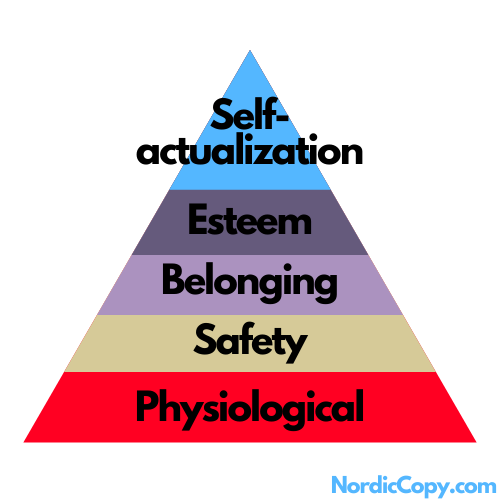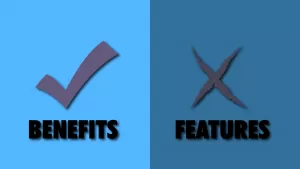This is Maslow’s famous hierarchy of needs:


What does it actually mean?
Why is it so interesting?
Why is it taught in virtually any marketing 101 class?
Read on to find out. ????
- Physiological (basic need)
- Safety (basic need)
- Belongingness and love (social need)
- Esteem (social need)
- Self-actualization (social need)
Physiological needs
Physiological needs ❎
Physiological needs are those you need to physically survive. So things such as food, water, and sleep. However, if we dig deeper and actually read Maslow’s papers, we see that things aren’t really that straightforward:
[…] it seems impossible as well as useless to make any list of fundamental physiological
Abraham Maslow in “A Theory Of Human Motivation” (1943)
needs for they can come to almost any number one might wish, depending on the degree
of specificity of description.
Before anything else, we strive to satisfy these basic needs.
We put all our energy into:
- Finding food
- Finding drinkable water
- Getting warm
- Getting dry
- Finding a place to sleep
Implications for marketers and copywriters
Desires you can tap into at this level are:
- Satisfying hunger easily and quickly
- Buying warm clothes during winter
- Dry socks during autumn
- Roof repairs during rainy seasons
- Fixing drains causing contaminated water
At this point, finding love, fitting in, being entertained, or fulfilling one’s life goals isn’t relevant. It’s all about survival. All about feeling physically ok.
Safety needs
Physiological needs ✅
Safety needs ❎
We can only move on from focusing on physiological needs when they have been adequately met.
Again, as in the hungry man, we find that the dominating goal is a strong determinant not only of his
current world-outlook and philosophy but also of his philosophy of the future. Practically
everything looks less important than safety […]A. Maslow (1943)
Safety is knowing that you can go to bed without a loaded gun beside you. It’s knowing your doors are locked and your bank account secure.
In extreme cases, safety becomes the sole focus of your existence. Internment camps, life in (some) prisons, the aftermath of a catastrophe (hurricanes, floods, volcanoes etc.).
“We’re in survival mode” is an expression used to demonstrate how dire things are. In other words, you’re not interested in belongingness, your self-esteem, or self-actualization. No point in painting a ship if it’s sinking.
In a sense, stability could be seen as a close synonym to safety needs. This explains why it’s easier to get re-elected than elected in the first place. It’s why students generally take the same seat every lecture, even if there’s no logical reason for it.
“The fear of the unknown” implies that what is known isn’t to be feared.
Why is this relevant for marketers?
The second and last basic need, safety, is what insurance salesmen target in their pitches.
Copywriting great Joe Sugarman based his burglar alarm ad on this need:
Every kind of product that protects, cares, shelters, prevents, or defends against threats focuses on the safety need.
- Burglar alarms
- Fences
- Security cameras
- Self-defense classes
- Self-defense items (mace, whistles)
- Sunscreen
- Savings accounts
Marketing in these areas often appeals to how agonizing it is to lose something. Visuals are scary and paint a picture of how horrible it would feel to have your house burgled, your life threatened, or simply not being in control.
Belongingness and love
Physiological needs ✅
Safety needs ✅
Belongingness and love ❎
He will hunger for affectionate relations with people in general, namely, for a
Maslow (1943)
place in his group, and he will strive with great intensity to achieve this goal. He will
want to attain such a place more than anything else in the world and may even forget that
once, when he was hungry, he sneered at love.
How To Make Friends And Influence People is one of the most popular books ever published in Western literature.
Why?
Because it targets people in this phase of Maslow’s needs.
It gives readers a clear path on how to become loved and how to find a group. Nowadays finding your in-group is easier than ever before. Like knitting? There are hundreds of Facebook groups, subreddits, forums, and social channels devoted to it. You can find your group within seconds online regardless of the hobby or profession. Everything from infosec professionals to copywriters to farmers.
How to market to this audience?
This need is bombarded with info-products on a daily basis. How to find love, how to talk to women, how to seduce guys… Online dating in the form of mobile apps or websites… Courses… Marriage advice… There’s an endless supply of products for people in this phase.
Marketing to people in this phase is usually easy. Because we’ve all been there. Knowing the challenges and hardships, and being able to empathize with your audience is often the hardest part of creating powerful communication. Not in this phase.
There’s also a multitude of niches and sub-niches to target. Think:
- Single parents in their 30s
- Insecure college kids feeling anxious about parties
- People starting new jobs, wondering how to fit in
Esteem
Physiological needs ✅
Safety needs ✅
Love and belonging ✅
Esteem ❎
All people in our society […] have a need or desire for a stable, firmly based, (usually) high evaluation of themselves, for self-respect, or self-esteem, and for the esteem of others.
Maslow (1943)
Ie. everybody wants to feel good about themselves.
Maslow categorizes this need into two sets:
- The desire for achievement, adequacy, and confidence.
- The desire for prestige, recognition, and reputation.
How to market to people in this phase
Plenty of books are targeted for this audience. For succeeding in the workplace and garnering a positive reputation, there are books like:
- 48 Laws of Power by Robert Greene
- Sun Tzu’s Art Of War by Sun Tzu
- Extreme Ownership by Jocko Willink and Leif Babin
… and most “how-to” styled literature.
The old adage of ‘benefits, not features’ is exemplified in the marketing of these offers:
- Visual imagery of what it feels like to be respected at work, at home, and by your friends
- Hero’s journey -stories that future pace the journey from being insecure to being confident
- Social proof in the form of other customer’s transformation
Self-actualization
Physiological needs ✅
Safety needs ✅
Love and belonging ✅
Esteem ✅
Self-actualization ❎
A musician must make music, an artist must paint, a poet must write, if he is to be ultimately happy. What a man can be, he must be. That need we may call self-actualization.
Maslow (1943)
Ie. to live up to what you think your potential is. To become everything you’re capable of becoming. Becoming what you want to be.
Is self-actualization a specific thing? Fulfilling a specific need?
No.
It’s the last phase of Maslow’s needs and the specific forms it will take depends on the person.
How to market to this phase
The loose definition of this need makes it challenging to give clear examples and tips.
Let’s put it this way. This phase is no longer a basic need. It’s most likely the newest one – from an evolutionary perspective.
If it’s no longer a basic need, you have no basic appeals left to work with either.
Example:
30+ middle-class people learning to play the guitar.
Do they do it to survive? Only if they use it as a weapon.
To feel safe? No.
To feel loved? Hopefully not.
To improve their self-esteem and feel respected? Maaaybe, probably not.
To improve at something they like? Yes! We have a winner!
So, how do you market to these people?
- Focus less on respect and earning the admiration of others (although that could and does work for a younger audience).
- Emphasize being one with the instrument.
- Emphasize what it feels like being an expert.
- Show and describe the flow-state experts enter when playing the guitar.
- Ie. show them what it feels like to be a musician, a guitarist, an artist!
In a nutshell
Maslow’s hierarchy of needs is a great tool to use when figuring out the angle of your marketing efforts.
What need are you appealing to? You should be able to categorize your ads into one of the 5 needs. If you don’t, reassess.
Always keep in mind the fundamental copywriting rule of selling benefits, not features.
Not all customers buy a weight-loss course for the same reason (they’re not in the same phase of Maslow’s needs):
- Some lose weight to fit in their old clothes, not wanting to age.
- David Goggins (author of Can’t Hurt Me) lost weight to pass the US Navy Seal entry exam. This had nothing to do with aging.
Most products can be marketed to several of Maslow’s needs. A parenting guide could be tailored to target a parent’s desire to be seen as a good mother/father (self-actualization). But it could just as well appeal to their desire to keep their newborn safe (safety).
It’s up to you to choose.



